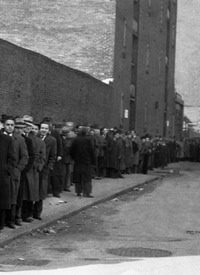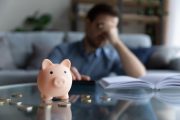
The unremitting flow of negative news about the economy has finally caught the attention of the mainstream media, causing an increasing number of economists to make comparisons between today’s recession and the Great Depression.
David Rosenberg, Gluskin Sheff’s chief market economist, commented to his clients that the monster drop in new home sales in June compared to May was not exactly “a one-month wonder” but instead invited comparison of the current recession’s similarities with those of the Great Depression. He said they include:
Coming off a crash (‘29) and rebound (‘30); aftermath of an asset deflation and credit collapse banks fail (Bank of New York back then, Lehman this time around); natural disaster (dust bowl then, oil spill now); global policy discord (with the U.K. then, with Germany now); geopolitical threats; interventionist governments; ultra low interest rates (long bond yield finished the 1930s below 2%); chronic unemployment (25% then, 17% now); deflation pressures; competitive devaluations; gold bull market (doubled in Sterling terms in the 30s); debt defaults; sputtering recoveries and rallies; [and the] onset of consumer frugality.
Writing in the Wall Street Journal, Donald Luskin, chief investment officer at Trend Macrolytics, asked, “Should we be worried about an economic relapse like 1938?” Luskin remarked that the U.S. stock market lost 56 percent of its value by March 2009, whereas at the same point during the Great Depression, stocks were down 49 percent. Fourteen months after the March low, however, stocks had gained nearly 80 percent, still 35 percent below the previous high. Luskin points out: “After the June, 1932 bottom in the Great Depression, stocks [also] rallied more than twice that, 177 percent … [but] were still down 61 percent from the 1929 peak."
Other popular mainstream economists are comparing the two periods, including Princeton economics professor Paul Krugman, here and here.
In closing one of his op-ed pieces for the New York Times, Krugman asked: “How bad will it be? Will it really be 1937 all over again? I don’t know. What I do know is that economic policy around the world has taken a major wrong turn, and that the odds of a prolonged slump are rising by the day.”
Adam Shell, writing for USA Today, explained: “Consider the aftermath of the 1929 stock market crash. After an initial drop of nearly 48% the Dow enjoyed five bull market rallies, with gains ranging from 23.4% to 48%, [according to the] Dow Jones Indexes. But each rebound was followed by a sizable relapse, with declines from 37.4% to 53.6%. Each relapse led to lower lows and the Dow’s eventual record bear market decline of 89.2%”
With weak numbers coming from manufacturing, retail sales, factory orders, employment, auto and home sales, even former Fed Chairman Alan Greenspan was forced to admit that the economy has hit an “invisible wall.”
Edward Yardeni points out other similarities with the Great Depression and today. “Obama is anti-business, and business is anti-Obama; this is the ‘meme du jour’” reflecting the anti-business stance taken by the Roosevelt administration at the bottom of the Great Depression. And in a note to its subscribers, InformedTrades.com stressed the similarities:
Both were preceded by an extensive period of credit-fueled bubbles. Before there was the Great Depression there was the Roaring ’20s; likewise, before Depression 2.0 were the Greenspan NASDAQ and housing bubbles. Consistent with Austrian business cycle theory, the end result of a credit-fueled bubble will be a corrective recession that purges out the malinvestments resulting from an excessive expansion of the money supply.
Both were marked by government interventionist policies designed to prevent falling asset prices. For instance, bans on short selling occurred in 2008 and at the beginning of the Great Depression. Likewise, stimulus packages were the prescribed remedy at the onset of the Great Depression, and are in vogue once again now. It’s worth noting they were unsuccessful back then, and don’t appear to be succeeding now.
Noted Harvard economist Niall Ferguson took the comparison one step further, building the case that this recession could be even worse than the Great Depression. Under Roosevelt, deficits peaked at 5.6 percent in 1934, and the federal debt rose only slightly before World War II. He said, “It was the war that saw the US embark on fiscal expansions of the sort we have seen since 2007. So what we are witnessing today has less to do with the 1930s than with the 1940s: it is world war finance without the war.” (Emphasis added.)
Thomas DiLorenzo, professor of economics at Loyola College, reviews the policy decisions made under the current administration as being exactly the opposite of those needed to revive the economy, including more centralized power being given to the Fed despite it’s critical role in creating the bubble in the first place, expanding FDIC insurance guarantees that increase the moral hazard involved in making risky loans rather than decrease it, increasing taxes instead of cutting them, “soaking the rich” rather then letting them invest their capital in new jobs and equipment, increasing public works projects that takes capital away from the private sector, keeping prices and wages above market-clearing levels, and “demonizing the entire American capitalist system as a means of shifting the blame for the economic crisis that its own … policies have created.”
Neeraj Chaudhary, an Investment Consultant with Peter Schiff’s Euro Pacific Capital, concluded in its recent client newsletter, “I remain concerned that Great Depression II could develop into something far more devastating that its predecessor.”
The S&P 500 stock market index is often considered a “predictor” of coming economic behavior. This chart presents a “most worrisome analogue,” according to Luskin. “Over the last year the stock market has followed a path eerily similar to 1937…. Will we continue on the path that led the correction of 1937 into a collapse in 1938?”
Ferguson says that “the remedy for such fears must be [a] … policy regime-change.… The choice [is not] between stimulus and austerity, it [is] between policies that boost private sector confidence and those that kill it.”
Photo of Great Depression: AP Images



